What’s the Role of the Director in a Haunt Attraction, and Do You Need a Director at Your Haunt?
I’m really excited about this blog, which is based on Episode 18 of the A Scott in the Dark podcast, which is titled, “The Director is the Lens, Not the Sun.” The podcast was based on a request from our Facebook Group. I mentioned this topic in an earlier episode, and a couple people went onto our Facebook Group and said, “That’s a great idea. Why don’t you do an episode on direction?” We all think about haunt actors, designers, and people who build haunts. What we don’t think about too often is what a haunt director does, and whether we need one. As a haunt owner, is this something you should be considering. I think you need a director, and I’m going to explain why this often unseen element is important for most haunted attractions and theater in general.
Before I get to this, I need to point out that the podcast episode on which this blog is based isn’t on YouTube because I didn’t record it in my home studio. I was sitting in a parking lot in my Mazda3 when I recorded it. I was in between meetings, and I didn’t want to drive home, so I decided to record an episode.
What a Director Is and Does
So, let’s get to talking about direction for haunted attractions. We should probably start with what a director is and does. People have different views on what a director is and what their responsibilities are. What I’m going to share here isn’t the be all and end all that leaves no room for anyone else’s opinion. I’m going share my views about directors for haunted attractions or any theatrical experience—whether it’s on stage, in a haunt, an immersive theater piece, or whatever—and you can see if it makes sense.
Here’s what I think a director basically does for a theatrical experience: The director is the lens that focuses the light that everybody else brings to the project. I know that’s kind of metaphorical but think about it this way—the director is the person who takes all the sunshine out there and focuses it into a tight little beam that has the power to burn ants. Something like that. The director takes a bunch of random creativity and focuses it into something that’s impactful and important.
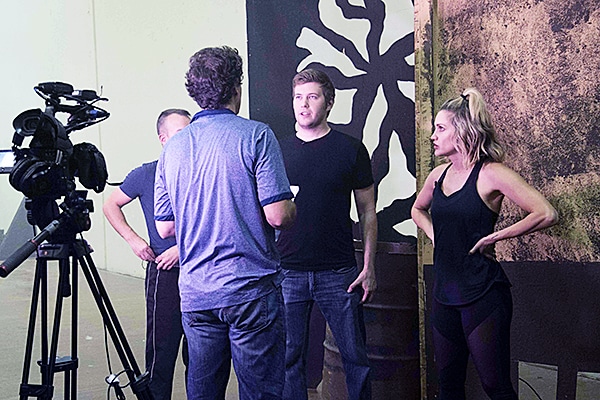
A Good Director Makes Everyone Else’s Work Look Better
Now, all too often, I’ve run into directors in my career who don’t believe their job is to focus the sun. They believe they are the sun, and the rest of the universe revolves around them. That’s clearly not true. A good director is someone who’s able to recognize their job is to make everyone else’s work look better. Their job is to keep everybody on track. The director is the person who maintains and is responsible for the artistic integrity—or alters it, if necessary. Is the final product the same one that was talked about when you were all sitting around having drinks going, “Hey, let’s do a haunt!”? Many haunts start that way—with alcohol—and that’s probably why they continue that way—with alcohol.
The director is the one who takes the idea of, “Let’s do a haunt about pirates who’ve passed on and are sailing in a ghost ship.” I know. That’s “Pirates of the Caribbean.” The director makes sure the haunt keeps to that vision and doesn’t start introducing clowns, Freddy Krueger, and all that. So, first of all, the director keeps everything focused.
The Director Takes Responsibility for the Live Performers
Next, the director is the person who takes responsibility for the live performers. Directors work with all the other designers as well, keeping open and honest communication going with them, but the director is most responsible for the live performers. We’ll talk about not just what the director does but how do they do it in just a minute when we talk about actors. In my opinion, the director is the creative “the buck stops here” kind of guy. In other words, if something goes awry creatively—for example, it hasn’t been communicated to the lighting designer that there’s a performer in a certain place, and the performer ends up standing in the dark—that’s the director’s responsibility. Yes, the lighting designer should read the script or venue flow to know what’s going on, but it’s the director’s responsibility to make sure all the parts come together, stay focused, and create something amazing, terrifying, and true to the vision that was there from the beginning.
I’ve been very lucky, because, in most cases, I’ve directed pieces I wrote, so I didn’t have to go back to the writer and say, “I want to change this, because this happened in rehearsal, or we discovered this.” There are times where, in the past, directors would have to go back to the writer and say, “Is it okay if we change this or alter this?” It’s up to you, but it’s important to identify who has that final say—the writer or the director. Someone has to have the final say from a creative standpoint. Obviously, the people who sign the checks ultimately have the final say, but, as a director, it’s your job also, if you’re working in more of a corporate setting. I realize some of you are home haunters, so maybe all you have to do is go to your husband or wife and say, “I’d like to change this. Can I have another $75 to go to the hardware store?” You probably don’t have to worry that much about this sort of thing. But, if you’re in a corporate setting or you have multiple owners of a haunt, the director is the one who has to go to them and say, “We thought we were going to do this, but when we put it into practice, we were having problems making it work, so here are some other alternatives.”

Casting—Putting the Right People in the Right Jobs
I have a broad definition of what a director’s responsibilities are. Some people just want directors to hire and train actors. I think that’s a little short-sighted, because, all too often, the actors are doing one thing and the scenic, lighting, and audio are doing something else. In many cases, the actors are told to wear whatever they want in terms of costume. If you don’t have a strong director, you don’t have anyone to keep that in line. It’s all focused on the overall story you’re trying to tell. Yes, I realize that’s the costume designer’s job, but if you don’t have a costume designer and everybody is bringing in their own stuff, those decisions fall to the director. Again, in my opinion, the director is the one who’s responsible for the creative success or failure of any haunted attraction or immersive piece of theater.
Let’s talk about the practical side of what a director does. This is nebulous territory, and there’s a lot of discussion about is something the director’s job or the lighting or scenic designer’s job or the actor’s job. In my opinion, the most important job of a director is to put the right people in the right jobs—which basically translates to casting, casting, casting. I’ve done shows and seminars and talks on the importance of the audition and how to set up the actual audition process. I have a podcast on this that you can listen to, so I won’t get into auditions here. Or, if you’re going to be in California this summer, this is what I’m teaching about at Midsummer Scream—tips and tricks for actors and how to run auditions.
As the director, you have to continually find that balance between super-talented artists and really good people. If you cast people who are super-talented but absolute jerks to work with, they’ll be a poison that spreads through your entire cast, and it will ruin your experience. No matter how good they are, if they’re jerks, they’re jerks, and they’re going to ruin the haunt. On the flip side, if you’re only hiring friends and people you really like to work with but aren’t very good actors, that’s going to lead you down a negative path as well.
In terms of casting, when a director looks at people who are auditioning, volunteering, or whatever, I think about 40% to 50% of what role the director puts them in is based on how they look. I know that doesn’t sound fair. I’m 6’4” and not slender, so I’m clearly not going to play some sort of troll, gnome, or pixie in someone’s haunted attraction. So, whether we like it or not, 40% or 50% of casting is based on how the person looks.
When I’m casting, I look for people’s ability and willingness to follow direction. As part of the audition process, I usually try to change what I’m asking people to do and see how quickly they follow that change. I also like to do an interview where you actually sit down and talk to the person, so they understand exactly what the responsibilities are, what time they need to be there, that they have to learn to do their own makeup, that they have to do physical and vocal warmups so they don’t hurt themselves, and the rules of the house—no touching or whatever. I explain all of that to them, and then I always ask if they have any questions or want to share information. You’d be surprised how many people will share information during the interview that you never thought to ask but that affects your decision to cast them or not.
Here’s an example from a zillion years ago when I was performing in atmospheric theater in theme parks. I was at an audition, and the director—who was doing the casting—asked somebody next to me, “Why do you want to work here?” They said, “I was working in a water park, and the supervisor was a real jerk and treated me like crap. We didn’t get along, he didn’t like me, and I didn’t like him, so I thought I’d come over here and work.”
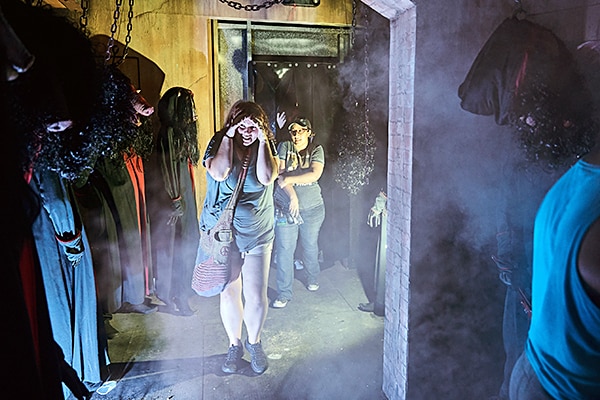
The director responded, “You realize that the majority of performance here is for children. You’re aware that you’re auditioning for a children’s theater experience in this theme park?”
“Yeah, yeah I know. I don’t really like kids, but I need the work.”
Clearly, this is somebody you don’t want to hire. If you’re casting for a haunt and somebody says, “I don’t really like working in the dark, and I don’t like to be around people who don’t like to drink,” chances are good this person shouldn’t be working in a haunted attraction. Just sayin’. So, when you’re doing the casting, take a good look at the person, and make sure you’re casting them in a role they can actually play.
I’ll share with you one of my favorite dumb casting stories, and this was my own fault. I had to cast twins, and I found these two great actresses. They auditioned at different times with makeup that made them look alike. What I didn’t take into consideration when I was casting was that one of them was probably four inches taller than the other. Not only were they to play twins, they were to play conjoined twins. Yeah, that was a really stupid mistake, but we were able to solve the problem by putting one of them in very high heels and the other in flats.
If you’re casting a character that reappears over and over throughout the house, make sure you stay within a height range and body type so, if you do casting over multiple days, you know they have to be between 5’8” and 5’10” and with an average body type—they can’t be too large or too small. As the director, make sure you pay attention to the physicality of who it is you’re casting and what they look like.
Casting is the first and most important job of a director—casting the right look, the right attitude, the right talent level, and how that all works in balance. Another thing I’d recommend with casting is, if you have a separate costumer, ask them to sit in and provide feedback. They might turn to you and say, “I’ll never get a tuxedo jacket for that 7’1” person.” That’s just a very practical factor, so don’t make a glaring error that’s going to throw your budget out of whack or have people of extreme sizes—large or small—walking around naked because the costumer couldn’t find anything for them to wear.
Working with the Designers
The director should also work with the designers. In other words, once the collaborative idea has been set, the director works with the designers to make sure the lighting reinforces what the actors are doing, scenic provides enough hiding spaces for the actors, and the guest path isn’t just a straight line. One of my biggest pet peeves when designing haunts is being sure the guest path winds so guests don’t walk in and see a long stretch of nothing. As guests turn each corner, make sure they see something new. This probably comes from designing for a theme park for so many years, where we basically had to conga line the guests through. They had to be in a nonstop line, because batching was difficult with the capacity we had to accomplish. That’s probably why I’m really big on twisty-turny pathways.
Work with your scenic designer so that your actors not only have a place to hide but also a place to escape. I’ll tell you about another stupid thing I did. I wasn’t the designer for this one; I was the director, but I just let it happen. We had an Egyptian-themed haunted house at Howl-O-Scream, and I had a character that was a living hieroglyphic. (This story was written by somebody else.) The wall was carved out where the person would stand, and the actor barely fit into that opening. Obviously, going back to our casting, the size of the actor is very important. So, we get that done, but what we didn’t take into consideration is that when a guest got scared and threw their hands up to try to protect themselves, this performer had no place to escape to. That meant the actor ended up getting hit on a pretty regular basis, because they had no escape route. So, as the director, work with your designers to make sure your actors are taken care of.
If you use microphones, make sure you’re working with your audio designer so you have the information the actors will need. Let them know how the microphone is worn and what they’re supposed to touch as far as gain or what they’re not supposed to touch. Most audio designers I know will lock the microphones so the actor can’t turn themselves up or down. That’s left to the powers that be, and the director makes adjustments as needed. If you, as the director, see something brilliant in the rehearsal process and you want to change something slightly or move a character to a different location, you should have the foresight and insight to do that and communicate it appropriately to everybody on the team.
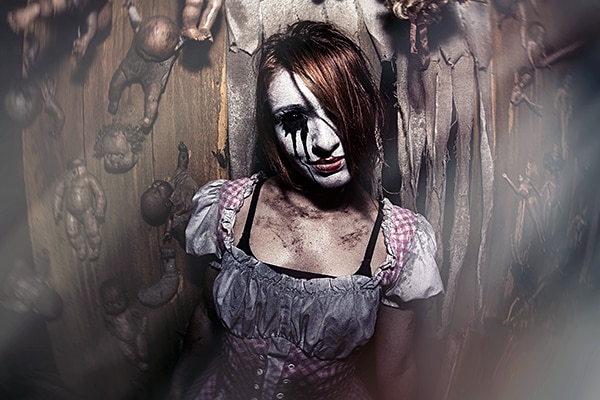
Training Actors—and Knowing Where They Are When They’re on Break
Another important component of the director’s job is training the actors. If you have a stage manager or assistant director or lead or somebody who’s in the house every night—and this person may be the director as well—involve them in the training. In large theme park scenarios where we have a multi-haunt experience with up to six different haunted houses and five different scare zones, each one of those has a stage manager. I train the stage managers first. I train them on what I expect each actor in each position to do. I make sure they understand perfectly, and then I let them train their own cast. I come through as the director and polish and make suggestions. That way, everybody who’s working—all of the actors—get used to going to one person with their problems and concerns, and I never have to hear, “Well, Scott said…”
That used to be a joke at Howl-O-Scream. Whenever actors wanted to do something the stage manager had told them not to do, they’d say, “Well, Scott said I could do this.” It got to be so bad that there was a mantra that all the stage managers would use, which was, “Scott said, and Alex agreed.” When we worked together, Alex Crowe, being the genius haunt guy that he is, would always say that. You eliminate all of that by training your stage managers and having them be the ones who train the actors. That way, there’s no breakdown in communication or fabricated communication. So, get your stage managers involved with your actor training.
Give the Actor Ownership of their Character
Make sure you find the right balance between providing the actors with enough structure so that they know how to be successful and yet leaving it open enough so their input can be incorporated as well. I know that may sound like a contradiction but hear me out for just a second. In order for an actor to be successful, they need to have a certain amount of structure. Think of it this way: You’re building them a jungle gym—or whatever that piece of park equipment is called these days—to play on, but what they do on that structure is up to them. The reason I say this is because my experience is that actors like to be right. If you say to them, “That’s what I’m looking for,” they immediately have a sense of success. Encourage them to take it in another direction, and reinforce what you like that they’re bringing to the role or bringing to the character.
The reason this part is so important is because these people are going to play these characters all night long, night after night after night—especially if it’s immersive theater, like Vault of Souls. When we did Vault of Souls, these people played these characters for three to four hours at a time. There had to be enough connection between them and their character that they could believably play these roles for long periods of time. It also gives the actor a sense of ownership of the character. When I write characters, I’ll say things like, “This is a voodoo queen. She’s domineering and powerful and she uses spells.” Then I’ll insert a line that says, “Have the actor create three spells and have them tell you what those spells actually do.” Again, give ownership to the actor to make it easier for them to play that character for long periods of time. I’ve put in enough structure to give them a sense of the character, but there’s enough freedom for them to provide their input as well.
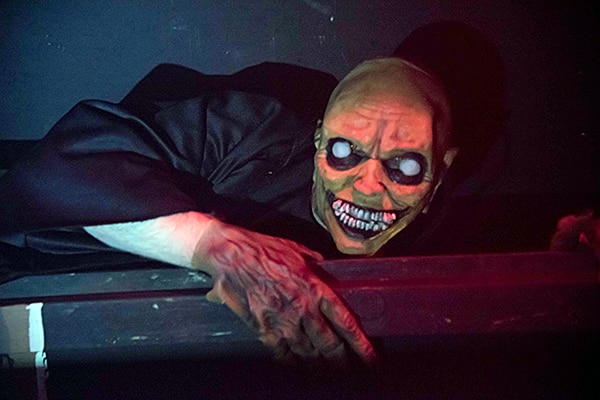
Keep Actors from Going Rogue
Once the rehearsal process is over, it’s locked in. In other words, don’t allow your actors to randomly change things without any sort of outside eye looking at it. When they do that, one of two things happens: Someone gets hurt or someone won’t be in the right place at the right time. When I say someone will get hurt, it can be the actor or a guest, because the performer is doing something outside of what was approved. As a director—and, more importantly, as a haunt owner—this can be dangerous. If you don’t know what your actors are doing, you’re the one who will have to foot the bill for the lawsuit if something happens. So, make sure that you give them structure, give them the freedom to develop, and, once it’s developed say to them, “This is where we are. If you want to change this, it must be approved before you do anything.” If you’ve allowed them enough input, they’ve probably already made any changes they want to make.
After the haunt opens and you have guests, it’s possible you may discover better ways for your actors to do something. As the director, you should be open to that, but again, once the haunt is open, the character is pretty much fixed in terms of how it’s going to be played. There are five, six, ten, or twenty things they can do, so be sure your actors are clear they can’t radically change anything without getting approval from the director, stage manager, or whatever your hierarchy happens to be.
Ask Questions of Actors to Develop Their Ownership of the Character
One of the most useful tools I’ve found for directing actors is using questions. Even if you have something specific in mind that you want, if you ask an actor a series of questions that lead them in that direction, not only will the actor feel they have more ownership but they’ll also discover and understand the nuances and subtleties you want them to have. In other words, you take them on a journey of discovery. During that questioning process, they often discover something even better than I had in mind. For example, let’s say I wanted this character to be played as someone mentally stunted at the age of seven but who’s hulking and threatening to the guests. I might start off by asking the actor, “How smart do you think this character is?”
“Well, he’s smart enough to hurt people if he really wants to,” might be the response.
“OK, why, then, doesn’t he have a gun or machete? Why is it just his bare hands, if he’s that smart?”
“Maybe he’s stronger than he is smart.”
“OK, so here he is, stronger than he is smart. I like that. That’s the right direction to go. So, is he 80% strong and 20% smart? Is he 50-50?”
“He’s probably 80% strong and 20% smart.”
“If you were 20% as smart as you are now, that would mean you stopped being smart at what age?”
“Maybe seven or eight years old.”
So, through a series of questions, I’ve led the actor to understand what the character is all about and given them a sense of ownership by going on that journey with me. It wasn’t me just saying, “He’s a giant baby.” Now, sometimes you may have to do that, especially if you don’t have a lot of rehearsal time, but I really do believe if you walk with the actor on the journey of discovery, you get a better product.
People might say, “I don’t have time to do that with every single actor,” and my response would be, “You don’t have the time not to.” Again, if you have any rehearsal process at all, by doing that, you lock in the character. You make it so both you and the actor understand who the character is and why that character is the way it is. Using questions is a very beneficial approach. You can also open it up so the actor can ask you questions. As an actor, I’ll quite often ask the director something like, “Are you saying he’s like a spoiled child?” I’ll use analogies that help me put the character into words and relationships that my personal experience allows me to understand. Sometimes, as a director, I’m not clear about a character, but, during the course of my discussion with the actor, we come up with something better than I could have written sitting in my office.
Here’s another important tip regarding directing actors: I try everything in the world not to demonstrate exactly what I want the actor to do. The only times I do that is if I’m dealing with actors who have no acting experience and will never get there on their own. In those cases, I’ll demonstrate and let them pretend to do it after me. If you have anybody who has any experience at all and they’re imitating what you do, chances are good they’re not going to do it well. They’ll have no sense of ownership, and I strongly recommend you don’t have them imitate you if you can avoid it. Get them to where you want them to be by questioning them. This works so much better.
One more thing to focus on in training is to make sure each actor knows where they fit in with the overall story. What’s the scare that happens before them? What’s the scare that happens after them? Why is their scare unique? This way, that actor can prep the guests for the next scare, or they know what the guests are coming from so they can take advantage of that. For example, if you have an actor behind a drop door and they have a bright light behind them, if they know the room before them is really dark, the moment that drop door hits, they realize all the guest is going to see is light. They’re going to have to reinforce that with some sort of sound or let the light come through and hit them first. They can stand up into the light, and it becomes a double scare. Making sure the actors know where they fit in the overall scheme of things makes them much stronger and sturdier. It will show those actors that you’ve brought them to a whole new level and given them the tools they need to succeed.
Also, I know it’s not really the director’s job, but it will win you big points with your cast if the director knows where and when the performers are on break. I’m a huge proponent of giving actors break time throughout the course of the night and having swings or double cast or whatever fill those holes, because that keeps everybody energetic throughout the evening. It’s critical to know where the actors are on break. Are they standing next to the person who’s performing for them? That’s not really a break. Direct your actors to take their break here in this trailer, this tent, this unused room, whatever. Work with your scenic designers to make sure that’s part and parcel of what’s there.

The Magic of Positive Reinforcement
To keep people in line, I’m a huge proponent of what’s called positive reinforcement. This is the way you train a dog, this is the way you train intelligent birds, this is the way you can train your husband or wife, this is the way you can train your kids, and this is the way you can train your actors. Catch them doing things right, and praise them for it. Reward positive behavior. If all you do as a director or a stage manager or any other person of authority is correct or punish people when they’re wrong, all they learn how to do is avoid being punished. They may still do the wrong, they’re just not going to get caught at it. If you reinforce positive behavior, they’ll try to do the right thing, so they’ll be rewarded. It’s not about avoiding getting caught doing the wrong thing, it’s getting caught doing the right thing. I always used to tell my stage managers, “Praise people publicly, redirect people privately.”
Praise People Publicly, Redirect People Privately
So, if somebody does a great job and gets a great scare, at your end-of-night meeting that day or beginning-of-night meeting the next day or when everyone is putting on their makeup, you can say, “I understand that Marsha (just to pick a name) over here got a great scare last night with that big bunch of frat boys that came through. The big one fell to the ground and started crying—all because of Marsha. Good job, Marsha.” That way, everybody knows Marsha did a good job, Marsha feels good, and they’ll go to her and say, “Hey, how did you get the big guy to fall down crying?”
On the flip side, say Marsha was busy texting in her hidey-hole when the frat boys went by, and I was right behind them. Not only weren’t they scared, they peeked around the corner and said, “Hey, she’s on her phone. That’s lame.” After my head exploded, I’d pull Marsha aside and say, “You know what? Those guys didn’t have a good time here. You missed an opportunity to scare them. Is that what you really want to do?” Do that privately, one on one. So, praise publicly, redirect privately. It helps with your cast’s feeling of self-worth, and it also helps them work harder for you.
Maybe some of you are thinking, “I have volunteer actors, so I can’t go that deep with them.” Actually, you can. If you have volunteer actors, they’re doing it because they love it. If you show you care as much about them as they care about the job they’re doing, they’ll do it better and will stick with you longer. Everybody likes positive reinforcement, especially if they’re not getting paid.
Redirecting privately doesn’t mean being a jerk. It doesn’t mean taking them in the back room and beating the crap out of them. And by the way, when I say redirect privately, I don’t mean walking into a crowded room and saying, “Excuse me, Joe, can I talk to you privately for a moment?” Everyone in that room is going to know exactly what that means: “Joe screwed up! Uh-oh”. No, don’t do that Mr. Director or Mrs. Director or Ms. Director. Miz Director—does that make her a magician? Think about that.
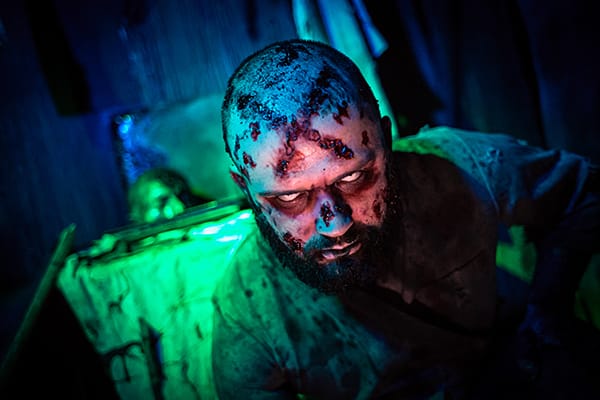
Model the Behavior You Want to See
If, in your entire season, you have 10,000 people come through your haunt, that’s 10,000 opportunities to do exactly the right thing and 10,000 possibilities that something will go wrong. The more consistent you are, the better your ratings will be. If everybody gets the same high-quality experience, nobody will get on social media and complain that your house is lame.
This is another of the director’s responsibilities—you have to set the tone with your actors and staff. Part of setting the tone is doing what you say you’re going to do. If you tell your cast to be on time, you need to be on time. Make sure your rehearsals start on time. Model the behavior you want others to follow. If you tell them they have to get along, take care of guests, and give 100% all the time, you, as the director, stage manager, or whatever, have to model that behavior. If you’re sitting on your butt in the corner on your phone and telling your actors, “Get out there and give 110%. Hey, I just got an extra life in Candy Crush!” you’re saying one thing and demonstrating something completely different. What you’re demonstrating speaks far louder than what you’re saying. Being the director doesn’t mean you’re less invested than the actors. You have to be more invested and focused on your job.
The sad thing is, being a director can be a pretty thankless job. The director is the first to get blamed when things don’t go right and the last to get recognition when they do. If the actor isn’t up to par, the director is the one who gets blamed. If an actor does a phenomenal job, they get the praise. I’m talking primarily about responses from guests. If a guest says, “The whole house sucks, and there was no focus,” it’s probably the director they’re talking about, whereas, if a guest says, “Oh my gosh! Everyone scared me over and over again! What a great cast!” If you’re the director, take that as a huge compliment. When someone says, “This cast works so well together,” take that as a phenomenal compliment, too.
In closing, let me say this. If you’re a small haunt, you may think you don’t need a director, and you may be right. However, someone has to take on that role—whether it’s the owner or the stage manager or, if you’re a home-haunt mom, you become the director. Someone has to make sure the actors are working in cohesive synchronicity with everything else in the house.
This is a huge topic, so, if you have any questions, please go to our Facebook group, go to AScottInTheDark.com or my website, or email me at [email protected]. Let me know your comments, both positive and negative. If you think I’m completely full of crap and you’ve done things for a zillion years in a completely different way, please let me know. I love those kinds of discussions. What I say on my show is based on my experience and the way I like to work. There may be as many different ways to work as there are people listening. So, for now, this is Scott Swenson saying, rest in peace.